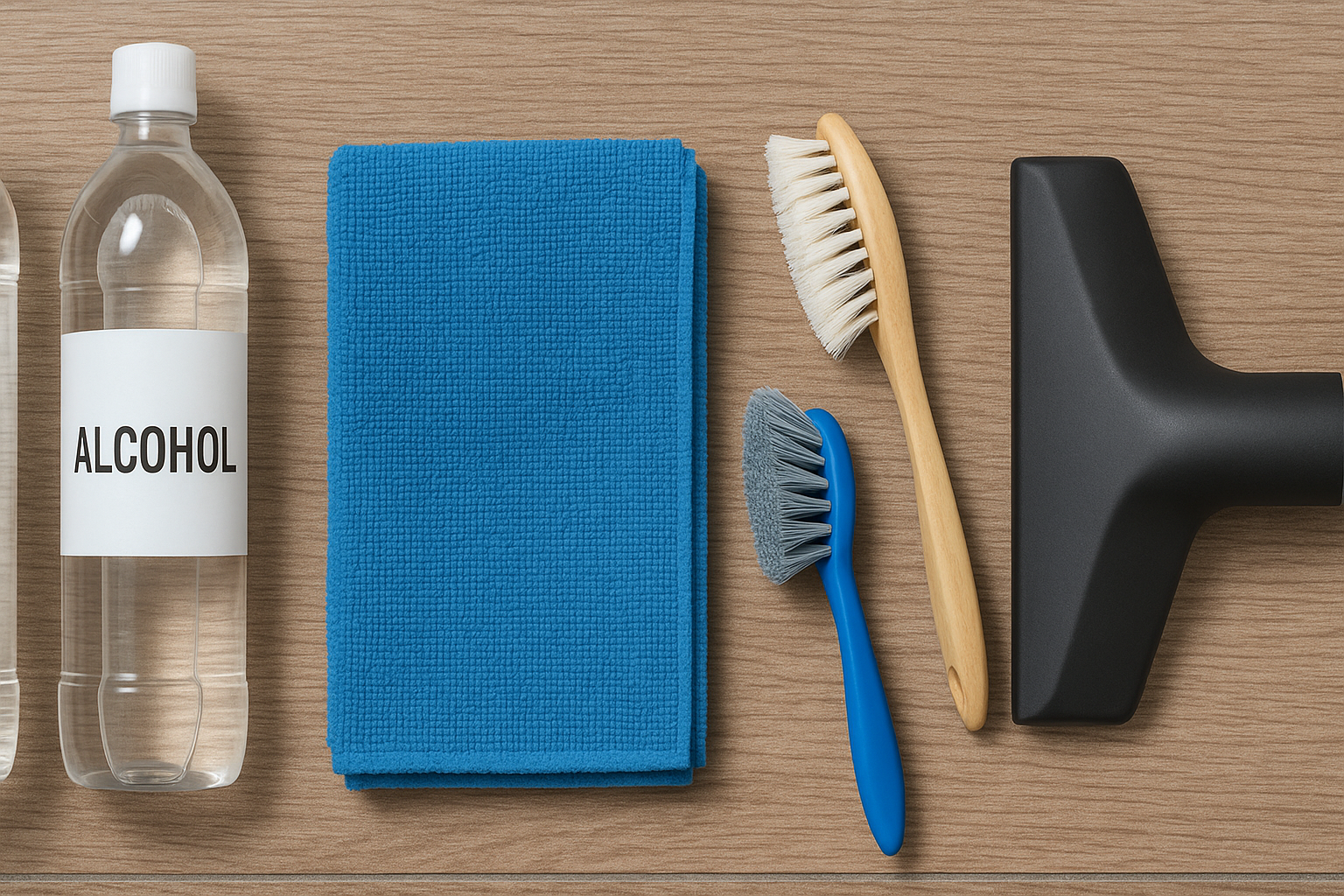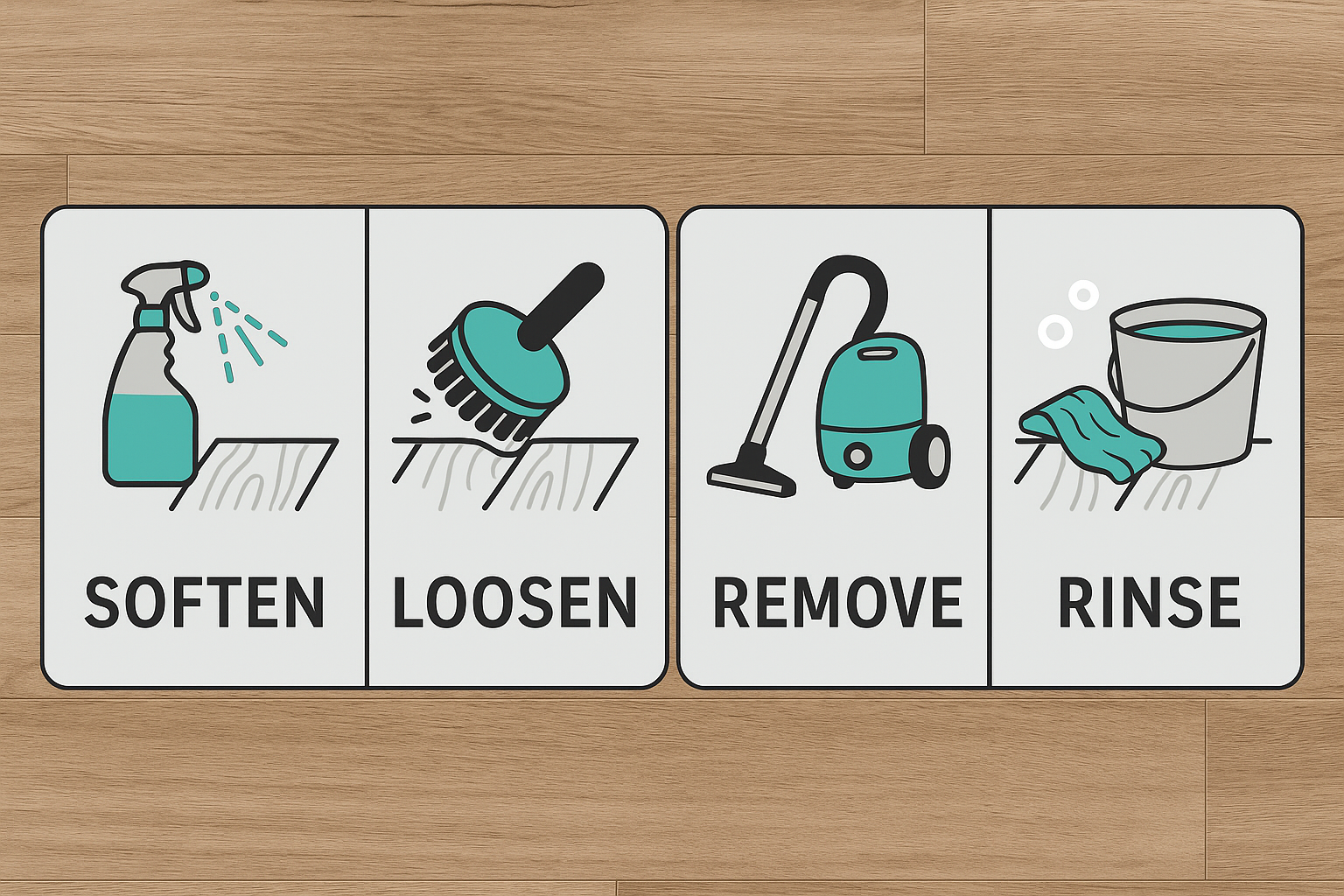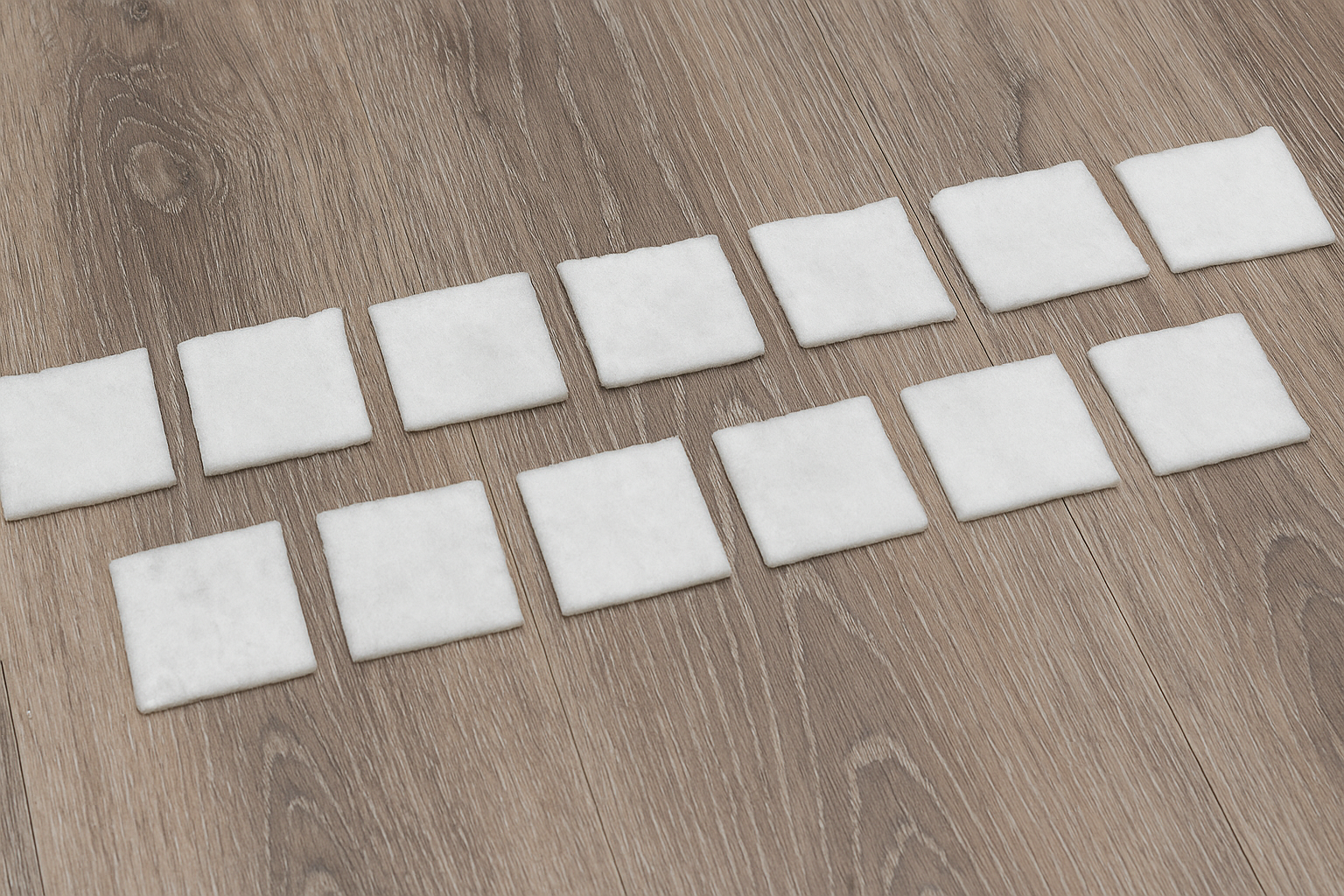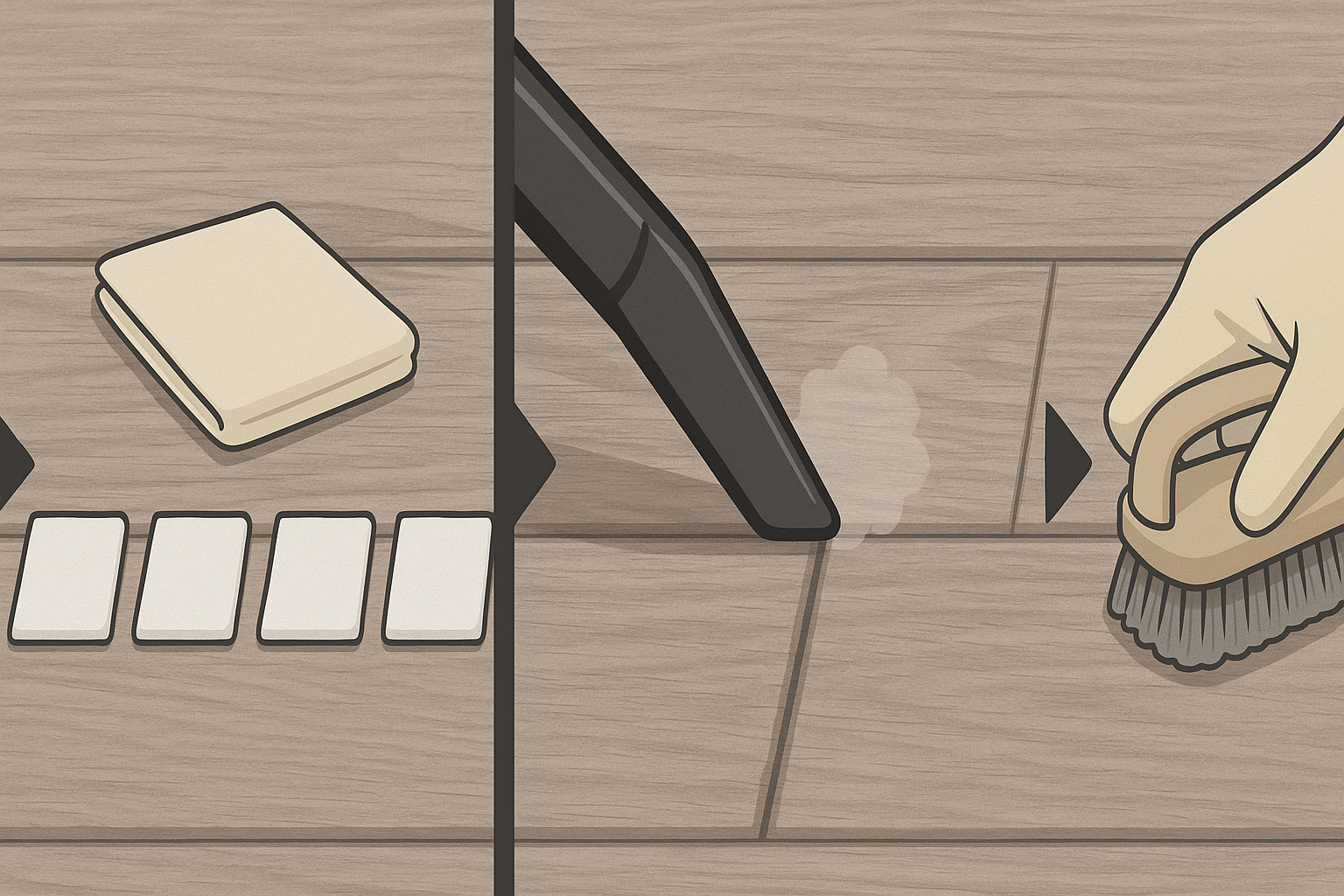How to Remove Caked Kitty Litter Dust from LVP Floor Grooves (Pro-Level, Step-by-Step)
Understanding Why Mopping and Scrubbing Fails
Most clumping litters—especially sodium bentonite clay—react with humidity or cleaning water and harden into a paste
that bonds inside the textured grain or seam gaps of luxury vinyl plank (LVP). Normal mopping or microfiber cleaning doesn’t work because:
• The residue becomes hydrophobic once dry — water beads off instead of penetrating.
• It’s locked into microscopic valleys in the vinyl wear layer.
• Standard mops provide too little friction to shear the hardened dust free.
That’s why a soft-mechanical + chemical lift method in controlled phases is required
When litter dust (especially clay/bentonite) mixes with moisture, it hardens in the textured grooves of luxury vinyl plank (LVP). This guide uses a controlled solvent dwell + targeted agitation + vacuum extraction process—exactly what floor restorers use when typical mops fail.
Supplies & Safe Mix Ratios
- Distilled water (prevents mineral film)
- White vinegar (mild acidic aid)
- Isopropyl alcohol 70% (wetting + fast evaporate)
- Mild dish soap (2–3 drops; optional surfactant)
- Microfiber cloths & mop pads (several, clean)
- Soft nylon toothbrush or grout brush
- Melamine foam (Magic Eraser), thin strips
- Paper towels or cotton strips (for targeted dwell)
- Shop vac with crevice + soft brush tip
- Optional: handheld steamer with detail nozzle; citrus cleaner (10:1) for binder residue; vinyl-safe cleaner or polish.
Primary Dwell Mix (per 2 cups total):
1 cup distilled water + 1 cup white vinegar + 1 tbsp isopropyl alcohol + 2–3 drops dish soap (optional). Mix fresh.

What You’ll Do (Method Overview)
- Loosen the hardened dust in the grooves with a targeted dwell (moistened strips laid along the seams).
- Agitate gently with soft nylon or melamine strips, moving with the groove lines.
- Extract the slurry immediately with a shop vac to prevent re-settling.
- Neutralize & finish with a quick rinse and dry to restore sheen and reduce future dust cling.

Phase 1 — Targeted Solvent Dwell (10–15 minutes)
The dwell lets moisture and mild solvent action wick into the caked dust so it can release from the vinyl texture.
- Pre-vacuum the area to remove loose granules.
- Soak paper towels or cotton strips with the Primary Dwell Mix, then wring to “damp,” not dripping.
- Lay strips precisely over the groove lines; press lightly so they contact the texture.
- Let sit 10–15 minutes (work in 3–4 ft sections to maintain control).
- Lift strips and set aside for disposal (do not drag across the floor).

Phase 2 — Controlled Agitation (With the Grain)
Use soft nylon or thin melamine strips. If your LVP has a matte finish, wrap a microfiber over the toothbrush to prevent micro-marring.
- Scrub along the groove line in short strokes, moderate pressure.
- Work a 2–3 ft groove length, then pause.
- Immediately wipe lifted residue with a clean damp microfiber.
- Repeat dwell + agitation if needed for stubborn sections.
Phase 3 — Vacuum Extraction (Prevent Re-Settling)
As residue liquefies, it can re-settle into nearby texture. Extract it as you go.
- Use a shop vac with crevice nozzle or brush tip.
- Hold the nozzle close to the groove while you agitate; vacuum the slurry immediately.
- Do a quick pass with a damp microfiber (plain distilled water) to remove traces.

Phase 4 — Neutralize, Rinse, and Finish
- Neutralize/De-film: 1 gallon warm distilled water + 1 cup vinegar. Light damp mop pass.
- Final rinse: Plain distilled water, lightly damp.
- Dry: Towel or dry microfiber to prevent watermarking.
- Optional sheen restore: Apply a vinyl-safe cleaner or polish per label (e.g., “for LVP”).
Advanced Options (For Stubborn, White/Chalky Grooves)
Spot Steam (Low, Targeted): Use a handheld steamer with a detail nozzle and nylon brush. Hold 2–4 inches above the groove for 2–3 seconds per section, immediately scrub and vacuum. Do not flood or slow-steam the entire plank area.
Citrus Cleaner (10:1 water:citrus) for Binder Residue: Lightly apply with microfiber, agitate, and rinse thoroughly. Always patch-test in a hidden corner first.
Prevention: Keep Grooves Clean Longer
- Litter mat with honeycomb or microfiber to capture granules.
- Consider low-dust litters (silica crystal or pellet types).
- Daily hard-floor vacuum setting near the box.
- Optional seam sealant (LVP-compatible) around the litter zone to minimize dust lodging.
- Small HEPA purifier near the box to cut airborne dust settling.
Printable Checklist
- □ Vacuum loose litter around box and baseboards
- □ Mix Primary Dwell solution (2 cups total)
- □ Lay damp strips along grooves (10–15 min)
- □ Agitate with soft nylon / melamine (with the grain)
- □ Shop-vac extract slurry immediately
- □ Quick rinse with distilled water
- □ Neutralize pass (1 gal water + 1 cup vinegar), then final rinse
- □ Dry thoroughly; optional vinyl-safe polish
- □ Place litter mat; set up daily spot-vac routine





